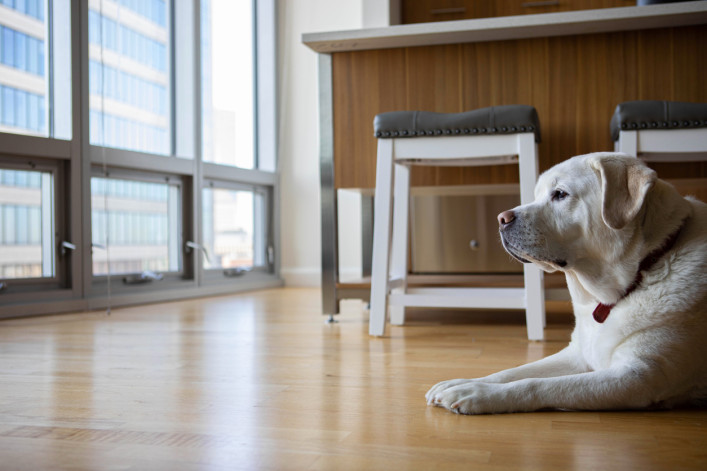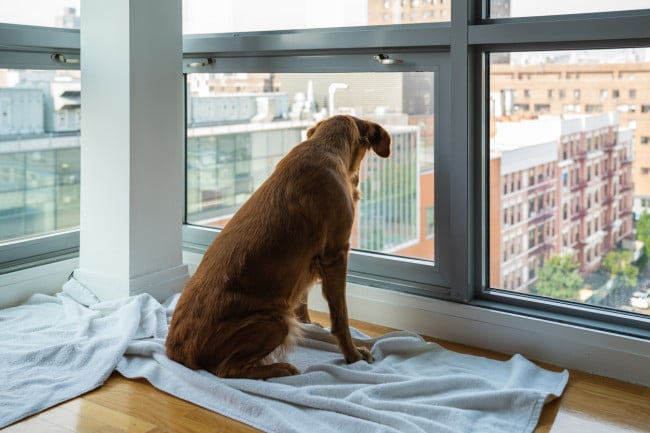Are pet-friendly apartments more expensive in NYC?

Buildings that allow pets tend to be pricier in general because there are other amenities on tap or because they are in a desirable location—or both.
iStock
Pet adoptions soared during the pandemic, which means renters and buyers who are now looking for an apartment in New York City are more likely to be doing so with a dog or cat in tow. If that’s you, better check your bank account, because you’ll pay more to live in a pet-friendly building.
But don't get mad at Fluffy. Buildings that allow pets tend to be pricier in general because there are other amenities on tap or because they are in a desirable location—or both. In other words, allowing pets is just part of the package.
Another reason? Allowing pets is a smart marketing move by buildings. Even if the seller or owner doesn’t own a pet—they understand the need to attract renters and buyers who do. More competition means higher prices.
Never one to waste a good pun: Looking at the cost of pet-friendly apartments is perhaps the definitive example of the tail wagging the dog, says Jonathan Miller, president and CEO of appraisal firm Miller Samuel.
Miller has tracked prices in pet-friendly buildings in Manhattan since 2011 (although he recently halted). His most recent data is through the first quarter of 2021, when the average sales price in a Manhattan building that allows pets was $2.2 million and the average price in Manhattan buildings that don’t allow pets was $911,304.
It’s more than double—but there’s an important caveat. Another reason why prices are so much higher in pet-friendly buildings is because they represent the majority of sales in a very pricey market. Miller says 93.8 percent of Manhattan transactions in the first quarter of 2021 were in pet-friendly buildings.
He says that high percentage of pet-friendly buildings has been “remarkably stable” since he started tracking.
“What we didn’t see was a progression toward a no-pet policy,” he says. It makes sense. “When a shareholder is selling, the more market segments they can attract, the higher the price they can attain.”
Plus, simply put, New Yorkers like their pets. “A change in the policy could result in acrimony,” he adds.
That being said, buildings that allow pets generally have limits on size and breeds and where pets are allowed. Some policies are so restrictive that the buildings don't seem friendly to pets at all.
NYC landlords reverse their no-pet policies
Many landlords that didn’t allow pets changed their position because of Covid—along with dropping rents and offering other concessions like free months and owner-paid broker fees.
James McGrath, co-founder of Yoreevo, a real estate brokerage that provides commission rebates, says landlords made the shift at the height of the pandemic because they had to. For example, an owner of an apartment in Fidi who was struggling to find a renter even though the place was being offered at a 40 percent discount. Landlords had to become more flexible, he says, otherwise “they had no leverage.”
He thinks these changes may be permanent even though the market now favors landlords.
“There’s no reason to walk it back if it is something that attracts renters. Allowing pets expands the pool of renters,” he says.
And sellers too. That was the case for a sales listing on Park Avenue he was recently involved with. When a potential buyer found out the building didn’t allow dogs—they canceled their appointment to see the place.
Allia Mohamed, co-founder and CEO of Openigloo, a site which has building and landlord reviews, says an analysis of over 20,000 rental listings from the past five years found that pet-friendly listings now make up the majority of available apartments.
In 2019, just 40 percent of listings indicated they were pet-friendly, in 2020 this jumped to 48 percent, then 50 percent in 2021, and of the rental listings posted so far in 2022, 63 percent are pet-friendly, she says.
Pet-friendly rentals are also much more expensive—but like for-sale apartments, allowing pets is not the only factor driving costs up.
“Pet-friendly buildings are on average 30-40 percent more expensive. However, there are other things that could explain this price difference that we didn't control for: neighborhood, amenities, size etc.,” Mohamed says.
You Might Also Like



























